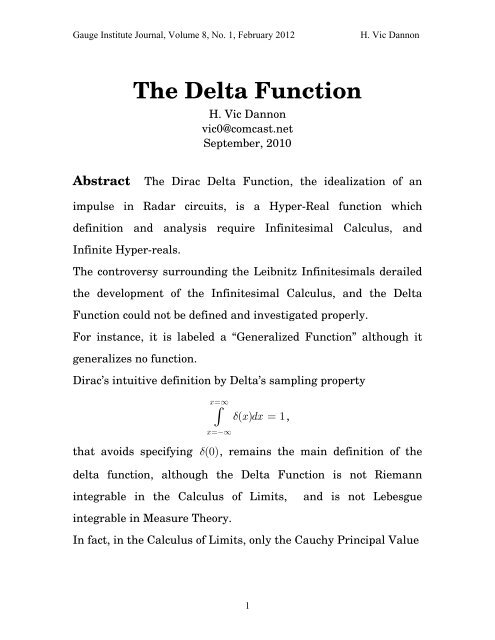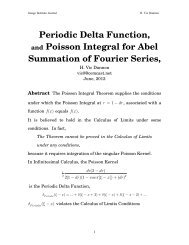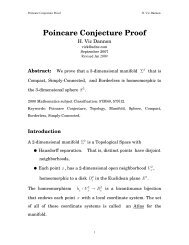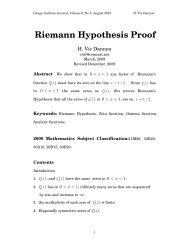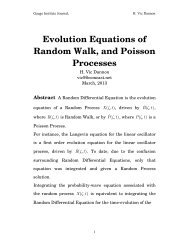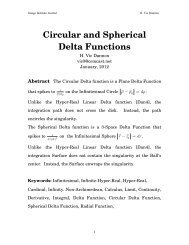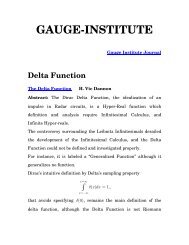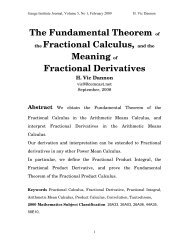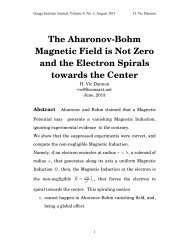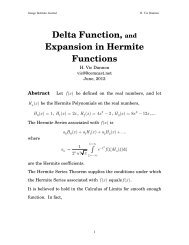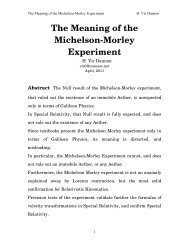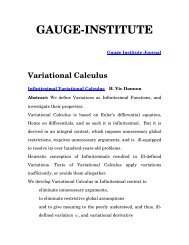Delta Function - Gauge-Institute
Delta Function - Gauge-Institute
Delta Function - Gauge-Institute
Create successful ePaper yourself
Turn your PDF publications into a flip-book with our unique Google optimized e-Paper software.
<strong>Gauge</strong> <strong>Institute</strong> Journal, Volume 8, No. 1, February 2012 H. Vic Dannon<br />
The <strong>Delta</strong> <strong>Function</strong><br />
H. Vic Dannon<br />
vic0@comcast.net<br />
September, 2010<br />
Abstract The Dirac <strong>Delta</strong> <strong>Function</strong>, the idealization of an<br />
impulse in Radar circuits, is a Hyper-Real function which<br />
definition and analysis require Infinitesimal Calculus, and<br />
Infinite Hyper-reals.<br />
The controversy surrounding the Leibnitz Infinitesimals derailed<br />
the development of the Infinitesimal Calculus, and the <strong>Delta</strong><br />
<strong>Function</strong> could not be defined and investigated properly.<br />
For instance, it is labeled a “Generalized <strong>Function</strong>” although it<br />
generalizes no function.<br />
Dirac’s intuitive definition by <strong>Delta</strong>’s sampling property<br />
x =∞<br />
∫<br />
x =−∞<br />
δ(<br />
xdx ) = 1,<br />
that avoids specifying δ(0)<br />
, remains the main definition of the<br />
delta function, although the <strong>Delta</strong> <strong>Function</strong> is not Riemann<br />
integrable in the Calculus of Limits, and is not Lebesgue<br />
integrable in Measure Theory.<br />
In fact, in the Calculus of Limits, only the Cauchy Principal Value<br />
1
<strong>Gauge</strong> <strong>Institute</strong> Journal, Volume 8, No. 1, February 2012 H. Vic Dannon<br />
Integral of the <strong>Delta</strong> <strong>Function</strong> exists, and it equals zero.<br />
Only in Infinitesimal Calculus, can the <strong>Delta</strong> <strong>Function</strong> be defined,<br />
differentiated, and integrated.<br />
Infinitesimal Calculus allows us to resolve open problems such as<br />
What is δ(0)<br />
?<br />
How is xδ( x)<br />
defined at x = 0 ?<br />
How is the <strong>Delta</strong> <strong>Function</strong> the derivative of a Step <strong>Function</strong>?<br />
How do we integrate the <strong>Delta</strong> <strong>Function</strong>?<br />
2<br />
What is δ (x)<br />
?<br />
2<br />
What is δ ( x)<br />
?<br />
3<br />
What is δ(<br />
x ) ?<br />
3<br />
What is δ ( x)<br />
?<br />
The <strong>Delta</strong> <strong>Function</strong> enables us to define the Fourier Transform<br />
with minimal requirements on the transformed function.<br />
Keywords: Infinitesimal, Infinite-Hyper-Real, Hyper-Real,<br />
Cardinal, Infinity. Non-Archimedean, Non-Standard Analysis,<br />
Calculus, Limit, Continuity, Derivative, Integral,<br />
2000 Mathematics Subject Classification 26E35; 26E30;<br />
26E15; 26E20; 26A06; 26A12; 03E10; 03E55; 03E17; 03H15;<br />
46S20; 97I40; 97I30.<br />
2
<strong>Gauge</strong> <strong>Institute</strong> Journal, Volume 8, No. 1, February 2012 H. Vic Dannon<br />
Contents<br />
Introduction<br />
1. Hyper-real Line<br />
2. <strong>Delta</strong> <strong>Function</strong> Definition<br />
3. <strong>Delta</strong> <strong>Function</strong> Plots<br />
4. <strong>Delta</strong> <strong>Function</strong> Properties<br />
5. <strong>Delta</strong> Sequence<br />
6. <strong>Delta</strong> Sequence<br />
n 1<br />
δ n(<br />
x)<br />
=<br />
2 2 cosh nx<br />
−nx<br />
n( x) ne ( x)<br />
[0, )<br />
δ χ =<br />
∞<br />
7. Primitive of <strong>Delta</strong> <strong>Function</strong><br />
8.<br />
9.<br />
10.<br />
δ(())<br />
fx<br />
n<br />
δ(<br />
x )<br />
n n<br />
δ( x − ( dx)<br />
)<br />
11. Integral of<br />
δ(<br />
x)<br />
12. The Principal Value Derivative of <strong>Delta</strong>: The Dipole <strong>Function</strong><br />
13. 2 nd Principal Value Derivative of <strong>Delta</strong>: the 4-Pole <strong>Function</strong><br />
14. Higher Principal Value Derivatives of <strong>Delta</strong><br />
References<br />
3
<strong>Gauge</strong> <strong>Institute</strong> Journal, Volume 8, No. 1, February 2012 H. Vic Dannon<br />
Introduction<br />
0.1 Cauchy, Poisson, and Riemann<br />
Cauchy (1816), and Poisson (1815) derived the Fourier Integral<br />
Theorem by using the sifting property of the <strong>Delta</strong> <strong>Function</strong>.<br />
By Fourier Integral Theorem<br />
Denoting<br />
k =∞ ⎛ ξ=∞<br />
⎞<br />
1 ⎜ ⎟ − ξ<br />
f ( x) = f( ξ) e ξ<br />
⎟<br />
⎜ ⎟<br />
2π<br />
⎜ ⎟<br />
k =−∞ ⎜ ⎟<br />
⎝ξ=−∞ ⎠⎟<br />
ik ikx<br />
∫ ∫ d e dk<br />
ξ=∞<br />
⎛ k =∞ ⎞<br />
⎜ 1<br />
⎟<br />
−ik( ξ−x)<br />
= f () ξ ⎜ e dk<br />
⎟<br />
∫ ⎜ ⎟ ξ<br />
⎜ 2π<br />
∫ ⎟d<br />
⎟<br />
ξ=−∞<br />
⎜⎝ k =−∞ ⎠⎟<br />
1<br />
2π<br />
k =∞<br />
∫<br />
k =−∞<br />
−ik( ξ−x) δξ<br />
e dk ≡ ( −x<br />
) ,<br />
the <strong>Delta</strong> <strong>Function</strong> is the Fourier Transform of the constant<br />
function 1,<br />
And Fourier Integral theorem states the sifting property for the<br />
<strong>Delta</strong> <strong>Function</strong><br />
ξ=∞<br />
∫<br />
f ( x) = f(<br />
ξδξ ) ( −x)<br />
d ξ.<br />
ξ=−∞<br />
In the derivation of his Zeta <strong>Function</strong>, Riemann (1859) uses this<br />
sifting property repeatedly, without using a function notation for<br />
4
<strong>Gauge</strong> <strong>Institute</strong> Journal, Volume 8, No. 1, February 2012 H. Vic Dannon<br />
k =∞<br />
1 −ik( −x)<br />
the integral<br />
2π<br />
∫<br />
k =−∞<br />
e ξ<br />
dk<br />
that represents the <strong>Delta</strong> function<br />
δξ− ( x)<br />
. The derivations are in [Dan4, p.84, p.90, p.97].<br />
The derivations were not supplied by Riemann. Riemann’s 1859<br />
paper, as well as much of Riemann’s published writings, outlines<br />
ideas, and states results without proof.<br />
In particular, the representation of <strong>Delta</strong> that follows from the<br />
Fourier Integral Theorem does not hold in the Calculus of Limits.<br />
Indeed,<br />
and the integral<br />
diverges.<br />
−ik( ξ−x)<br />
ξ = x ⇒ e = 1,<br />
1<br />
2π<br />
k =∞<br />
∫<br />
k =−∞<br />
−ik( ξ−x)<br />
e dk<br />
Avoiding the singularity at ξ = x does not recover the Theorem,<br />
because without the singularity the integral equals zero.<br />
Thus, the Fourier Integral Theorem cannot be written in the<br />
Calculus of Limits.<br />
In other words, the indeterminate nature of singularities in the<br />
Calculus of Limits does not allow the Fourier Integral Theorem to<br />
hold.<br />
5
<strong>Gauge</strong> <strong>Institute</strong> Journal, Volume 8, No. 1, February 2012 H. Vic Dannon<br />
0.2 Dirac<br />
The <strong>Delta</strong> <strong>Function</strong> can be realized as a Radar transmission<br />
Pulse. A Radar Transmission has to be pulsed because a<br />
continuous wave train will not allow us to measure the time<br />
interval τ between transmission and reception, and determine the<br />
range of the target by<br />
r = cτ.<br />
1<br />
2<br />
Thus, a transmission lasts very short time. Then, the Radar<br />
system converts into a receiver for the reflected signal. This<br />
process of transmitting and receiving repeats thousands of time<br />
per second, in order to follow a moving target.<br />
The Radar pulse envelops a carrier wave of very short wavelength.<br />
Radar carrier waves went down from centimeters to micrometers<br />
of light wavelength.<br />
1<br />
Since the illuminating power dissipation is proportional to 2 r<br />
, the<br />
short electromagnetic wave-train has an electric field that seems<br />
nearly infinite, although the pulse power is finite.<br />
Dirac (1930) was familiar with Radar Pulses when he defined the<br />
<strong>Delta</strong> <strong>Function</strong> in [Dirac, p.71] through the sifting property,<br />
and<br />
x =∞<br />
∫<br />
x =−∞<br />
δ(<br />
xdx ) = 1,<br />
6
<strong>Gauge</strong> <strong>Institute</strong> Journal, Volume 8, No. 1, February 2012 H. Vic Dannon<br />
δ ( x)<br />
= 0,<br />
for all x ≠ 0 .<br />
Dirac definition left open the question of the nearly infinite<br />
amplitude at x = 0 . That is, δ(0)<br />
was left undefined.<br />
Then, the sifting property does not hold.<br />
Indeed, since δ (0) is infinite, the integration of δ(<br />
x)<br />
has to skip<br />
the point x = 0 , and only the Cauchy Principal Value of the<br />
x =∞<br />
∫<br />
integral δ(<br />
xdx ) may exist. Then,<br />
x =−∞<br />
1 ⎛ x =−<br />
n<br />
x =∞ ⎞<br />
⎟<br />
⎜<br />
lim<br />
⎜ ⎟<br />
δ( xdx ) δ(<br />
xdx ) ⎟ 0<br />
→∞ ⎜ + ⎟ =<br />
⎜ ⎟<br />
⎜⎝x=−∞ x = ⎠⎟<br />
n<br />
x =∞<br />
in contradiction to δ(<br />
xdx ) = 1.<br />
∫<br />
x =−∞<br />
0.3 Laurent Schwartz<br />
∫ ∫ ,<br />
Laurent Schwartz presents his <strong>Delta</strong> Distribution as follows<br />
[Schwartz, p. 82]<br />
⎧ 0, x < 0<br />
Let Y = ⎪<br />
⎨ .<br />
⎪<br />
⎪⎩<br />
1, x > 0<br />
Then, for any ϕ(<br />
x)<br />
infinitely differentiable, that<br />
vanishes at ∞ , and at −∞,<br />
7<br />
1<br />
n
<strong>Gauge</strong> <strong>Institute</strong> Journal, Volume 8, No. 1, February 2012 H. Vic Dannon<br />
x=∞ x=∞<br />
∫ ∫<br />
Y '( x) ϕ( x) dx =− Y( x) ϕ'(<br />
x) dx<br />
x=−∞ x=−∞<br />
Thus,<br />
x =∞<br />
∫<br />
=− ϕ'( xdx ) =−ϕ(<br />
x)<br />
x = 0<br />
= ϕ(0)<br />
x =∞<br />
= ∫ δ( x) ϕ(<br />
x) dx<br />
x =−∞<br />
Y ' = δ .<br />
ϕ(0) = ∫ δ( x) ϕ(<br />
x) dx<br />
x =∞<br />
x = 0<br />
Since Yx ( ) is not defined at x = 0 , Y '(0) is not defined, and the<br />
conclusion Y ' = δ , avoids δ(0)<br />
.<br />
That is, Schwartz’ Definition is as incomplete as Dirac’s.<br />
Furthermore, the equality<br />
x =∞<br />
x =−∞<br />
is the definition of the <strong>Delta</strong> <strong>Function</strong> by its sifting property that<br />
does not hold.<br />
Since δ(0)<br />
is not defined, the integration has to skip the point<br />
x = 0 , and the integral is the Cauchy Principal Value Integral<br />
8
<strong>Gauge</strong> <strong>Institute</strong> Journal, Volume 8, No. 1, February 2012 H. Vic Dannon<br />
1 ⎛ x =−<br />
n<br />
x =∞ ⎞<br />
⎟<br />
⎜<br />
lim<br />
⎜ ⎟<br />
⎜ δ( x) ϕ( x) dx δ( x) ϕ(<br />
x) dx ⎟ 0<br />
→∞ ⎜ + ⎟ =<br />
⎜ ∫ ∫<br />
⎟<br />
⎜⎝x=−∞ x =<br />
⎠⎟<br />
n<br />
Like the Dirac <strong>Delta</strong>, the Schwartz <strong>Delta</strong> avoids δ(0)<br />
, and<br />
postulates the sifting property.<br />
0.4 <strong>Delta</strong> Sequence<br />
Attempts to get back to the singular <strong>Delta</strong> <strong>Function</strong>, replaced the<br />
<strong>Delta</strong> <strong>Function</strong> by a <strong>Delta</strong> Sequence of functions that converge to<br />
the <strong>Delta</strong> <strong>Function</strong>. For instance,<br />
= 1 1 = [ , ] ⎨<br />
2n 2n<br />
⎪⎪⎩<br />
δn( x) nχ ( x)<br />
−<br />
1<br />
n<br />
⎧⎪<br />
⎪nx<br />
, ∈− [ ,<br />
0, otherwise<br />
Then, the delta <strong>Function</strong> is defined as the limit<br />
δ( x) = lim δ ( x)<br />
.<br />
n→∞<br />
1 1<br />
2n 2n<br />
The sequential approach is reviewed in [Mikusinski], and is used<br />
in Mathematical Physics texts.<br />
However, the <strong>Delta</strong> Sequence contradicts Dirac’s definition.<br />
Indeed, as n →∞,<br />
δ(0) = lim δ (0) = lim n = ∞.<br />
n<br />
n<br />
n→∞ n→∞<br />
Then, the integration of δ( x)<br />
has to skip the point x = 0 .<br />
9<br />
]<br />
.
<strong>Gauge</strong> <strong>Institute</strong> Journal, Volume 8, No. 1, February 2012 H. Vic Dannon<br />
That is, only the Cauchy Principal Value of the integral<br />
x =∞<br />
∫<br />
x =−∞<br />
δ(<br />
xdx )<br />
may exist. The Principal Value is<br />
1 ⎛ x =−<br />
n<br />
x =∞ ⎞<br />
⎟<br />
⎜<br />
lim<br />
⎜ ⎟<br />
δ( xdx ) δ(<br />
xdx ) ⎟ 0<br />
→∞ ⎜ + ⎟ =<br />
⎜ ⎟<br />
⎜⎝x=−∞ x = ⎠⎟<br />
n<br />
x =∞<br />
∫<br />
∫ ∫ .<br />
That is, the sifting δ ( xdx ) = 1,<br />
is not preserved for the limit<br />
x =−∞<br />
of the <strong>Delta</strong> sequence, δ( x) = lim δ ( x)<br />
.�<br />
n<br />
n→∞<br />
0.5 The Hyper-real <strong>Delta</strong> <strong>Function</strong><br />
The above attempts failed because the <strong>Delta</strong> <strong>Function</strong> is a hyper-<br />
real function. A function from the hyper-reals into the hyper-<br />
reals.<br />
By resolving the problem of the infinitesimals [Dan2], we obtained<br />
the Infinite Hyper-reals that are strictly smaller than ∞ , and can<br />
serve to supply the value of the <strong>Delta</strong> <strong>Function</strong> at the singularity.<br />
The attempts to get by with Calculus restricted to the real line,<br />
deprived Calculus of its full power. In Infinitesimal Calculus,<br />
[Dan3], we differentiate over a jump discontinuity of a step<br />
function, and obtain the <strong>Delta</strong> <strong>Function</strong>. We can integrate over a<br />
singularity, and obtain a finite value.<br />
10<br />
n<br />
1<br />
n
<strong>Gauge</strong> <strong>Institute</strong> Journal, Volume 8, No. 1, February 2012 H. Vic Dannon<br />
Here, we present the <strong>Delta</strong> <strong>Function</strong>, and the properties of the<br />
<strong>Delta</strong> <strong>Function</strong> in Infinitesimal Calculus.<br />
In particular, we resolve open problems such as<br />
What is δ(0)<br />
?<br />
How is xδ( x)<br />
defined at x = 0 ?<br />
How is the <strong>Delta</strong> <strong>Function</strong> the derivative of a Step <strong>Function</strong>?<br />
How do we integrate the <strong>Delta</strong> <strong>Function</strong>?<br />
2<br />
What is δ (x)<br />
?<br />
2<br />
What is δ ( x)<br />
?<br />
3<br />
What is δ(<br />
x ) ?<br />
3<br />
What is δ ( x)<br />
?<br />
11
<strong>Gauge</strong> <strong>Institute</strong> Journal, Volume 8, No. 1, February 2012 H. Vic Dannon<br />
1.<br />
Hyper-real Line<br />
Each real number α can be represented by a Cauchy sequence of<br />
rational numbers, ( r1, r2, r3,...) so that rn α . →<br />
The constant sequence ( ααα , , ,...) is a constant hyper-real.<br />
In [Dan2] we established that,<br />
1. Any totally ordered set of positive, monotonically decreasing<br />
to zero sequences ( ι , ι , ι ,...) constitutes a family of<br />
infinitesimal hyper-reals.<br />
1 2 3<br />
2. The infinitesimals are smaller than any real number, yet<br />
strictly greater than zero.<br />
1 1 1<br />
3. Their reciprocals ( , , ,...<br />
ι1 ι2 ι ) are the infinite hyper-reals.<br />
3<br />
4. The infinite hyper-reals are greater than any real number,<br />
yet strictly smaller than infinity.<br />
5. The infinite hyper-reals with negative signs are smaller<br />
than any real number, yet strictly greater than −∞.<br />
6. The sum of a real number with an infinitesimal is a<br />
non-constant hyper-real.<br />
7. The Hyper-reals are the totality of constant hyper-reals, a<br />
family of infinitesimals, a family of infinitesimals with<br />
12
<strong>Gauge</strong> <strong>Institute</strong> Journal, Volume 8, No. 1, February 2012 H. Vic Dannon<br />
negative sign, a family of infinite hyper-reals, a family of<br />
infinite hyper-reals with negative sign, and non-constant<br />
hyper-reals.<br />
8. The hyper-reals are totally ordered, and aligned along a<br />
line: the Hyper-real Line.<br />
9. That line includes the real numbers separated by the non-<br />
constant hyper-reals. Each real number is the center of an<br />
interval of hyper-reals, that includes no other real number.<br />
10. In particular, zero is separated from any positive real<br />
by the infinitesimals, and from any negative real by the<br />
infinitesimals with negative signs, −dx<br />
.<br />
11. Zero is not an infinitesimal, because zero is not strictly<br />
greater than zero.<br />
12. We do not add infinity to the hyper-real line.<br />
13. The infinitesimals, the infinitesimals with negative<br />
signs, the infinite hyper-reals, and the infinite hyper-reals<br />
with negative signs are semi-groups with<br />
respect to addition. Neither set includes zero.<br />
14. The hyper-real line is embedded in � , and is not<br />
homeomorphic to the real line. There is no bi-continuous<br />
one-one mapping from the hyper-real onto the real line.<br />
13<br />
∞
<strong>Gauge</strong> <strong>Institute</strong> Journal, Volume 8, No. 1, February 2012 H. Vic Dannon<br />
15. In particular, there are no points on the real line that<br />
can be assigned uniquely to the infinitesimal hyper-reals, or<br />
to the infinite hyper-reals, or to the non-constant hyper-<br />
reals.<br />
16. No neighbourhood of a hyper-real is homeomorphic to<br />
n<br />
an � ball. Therefore, the hyper-real line is not a manifold.<br />
17. The hyper-real line is totally ordered like a line, but it<br />
is not spanned by one element, and it is not one-dimensional.<br />
14
<strong>Gauge</strong> <strong>Institute</strong> Journal, Volume 8, No. 1, February 2012 H. Vic Dannon<br />
2.<br />
<strong>Delta</strong> <strong>Function</strong> Definition<br />
2.1 Domain and Range<br />
The <strong>Delta</strong> <strong>Function</strong> is a hyper-real function defined from the<br />
hyper-real line into the set of two hyper-reals<br />
⎧ ⎪ 1 ⎫⎪<br />
⎨0, ⎪<br />
⎬.<br />
⎪ ⎪⎩ dx ⎪ ⎪⎭<br />
The hyper-real 0 is the sequence 0, 0, 0,... .<br />
The infinite hyper-real 1<br />
dx<br />
depends on our choice of dx . We will<br />
usually choose the family of infinitesimals that is spanned by the<br />
1<br />
n<br />
sequences 1<br />
n , 2<br />
1 , 3 n<br />
,… It is a semigroup with respect to<br />
vector addition, and includes all the scalar multiples of the<br />
generating sequences that are non-zero. That is, the family<br />
includes infinitesimals with negative sign.<br />
Therefore, 1<br />
dx<br />
will mean the sequence n .<br />
Alternatively, we may choose the family spanned by the sequences<br />
1<br />
1<br />
1<br />
2 n<br />
2 n , 2<br />
2 n , 3<br />
,… Then, 1<br />
dx will mean the sequence 2n .<br />
Once we determined the basic infinitesimal dx , we will use it in<br />
the Infinite Riemann Sum that defines an Integral in<br />
15
<strong>Gauge</strong> <strong>Institute</strong> Journal, Volume 8, No. 1, February 2012 H. Vic Dannon<br />
Infinitesimal Calculus.<br />
2.2 The <strong>Delta</strong> <strong>Function</strong> is strictly smaller than<br />
Proof: Since dx > 0,<br />
1<br />
dx
<strong>Gauge</strong> <strong>Institute</strong> Journal, Volume 8, No. 1, February 2012 H. Vic Dannon<br />
⎧⎪ 1, x ∈ ⎡− , ⎤<br />
=<br />
⎥⎦ ⎨ is the sequence<br />
dx ⎪⎪⎩<br />
0, otherwise<br />
dx dx<br />
1<br />
2.4 δ(<br />
x)<br />
⎪ ⎢⎣<br />
2 2<br />
where dx = in<br />
.<br />
⎧⎪∈ ⎡<br />
−<br />
⎨<br />
⎪<br />
⎪⎩<br />
0, otherwise<br />
1<br />
in in<br />
⎪ , x ,<br />
n i ⎢<br />
⎣ 2 2 ⎥<br />
⎦<br />
Namely, as a hyper-real function the value of <strong>Delta</strong> at the<br />
singularity is the infinite hyper-real 1<br />
dx<br />
infinite vector with countably many components.<br />
17<br />
which is a sequence, an<br />
⎤
<strong>Gauge</strong> <strong>Institute</strong> Journal, Volume 8, No. 1, February 2012 H. Vic Dannon<br />
3.<br />
<strong>Delta</strong> <strong>Function</strong> Plots<br />
3.1 <strong>Delta</strong> Plot for dx =<br />
If<br />
1<br />
n<br />
1 i n = , <strong>Delta</strong> is the infinite Hyper-Real number,<br />
n<br />
δ χ χ χ<br />
( x) = ( x),2 ( x),3 ( x),...<br />
[ −1,1] [ − , ] [ − , ]<br />
1 1 1 1<br />
2 2 3 3<br />
We plot in Maple the 10 th component with<br />
Similarly, we use<br />
18
<strong>Gauge</strong> <strong>Institute</strong> Journal, Volume 8, No. 1, February 2012 H. Vic Dannon<br />
to plot an the 100 th component of <strong>Delta</strong><br />
3.2 <strong>Delta</strong> with<br />
We use<br />
1<br />
2 n dx = is<br />
χ[ − , ] [ − , ] [ − , ]<br />
δ χ χ<br />
( x) = 2 ( x), 4 ( x),8<br />
( x ),...<br />
to plot the 4 th component of <strong>Delta</strong><br />
1 1 1 1 1 1<br />
4 4 8 8 16 16<br />
19
<strong>Gauge</strong> <strong>Institute</strong> Journal, Volume 8, No. 1, February 2012 H. Vic Dannon<br />
Similarly, we use<br />
to plot the 6 th component of <strong>Delta</strong>,<br />
20
<strong>Gauge</strong> <strong>Institute</strong> Journal, Volume 8, No. 1, February 2012 H. Vic Dannon<br />
4.<br />
<strong>Delta</strong> <strong>Function</strong> Properties<br />
4.1<br />
xδ ( x)<br />
= 0<br />
Proof: x ≠ 0 ⇒ δ ( x)<br />
= 0 ⇒ xδ ( x)<br />
= 0.<br />
4.2<br />
4.3<br />
x =<br />
0<br />
⇒<br />
0<br />
xδ( x)<br />
= 0 δ(0)<br />
= = 0,<br />
since dx > 0.<br />
dx<br />
1<br />
( x x ) ( x)<br />
δ − 0 ≡ χ⎡x0− dx, x dx ⎤<br />
dx ( x<br />
2 0+<br />
−<br />
2<br />
0)<br />
⎢⎣ ⎥⎦<br />
n<br />
=<br />
That is, δ (0) spikes to<br />
4.4<br />
1<br />
dx<br />
0 , dx<br />
dx 2 0 2<br />
χ⎡ − + ⎤<br />
⎢⎣ ⎥⎦<br />
( )<br />
x x x<br />
n 1<br />
δ ( x) = ( x)<br />
, n = 2, 3,...<br />
( )<br />
dx, dx<br />
n<br />
dx 2 2 χ⎡−⎤ ⎢⎣ ⎥⎦<br />
1<br />
( ) n<br />
dx<br />
, which is greater than 1<br />
dx .<br />
1 1<br />
(, xy) ≡ ()() x y = [ dx, dx () x ()<br />
] dy dy y<br />
−<br />
dx [ , ]<br />
2 2 dy −<br />
2 2<br />
δ δ δ χ χ<br />
21
<strong>Gauge</strong> <strong>Institute</strong> Journal, Volume 8, No. 1, February 2012 H. Vic Dannon<br />
5.<br />
<strong>Delta</strong> Sequence<br />
1<br />
δ n( x) = n<br />
2cosh<br />
Depending on the choice of the infinitesimal dx = in<br />
, there are<br />
2<br />
nx<br />
many <strong>Delta</strong> Sequences that lead to the <strong>Delta</strong> <strong>Function</strong>, δ(<br />
x)<br />
.<br />
5.1 Each<br />
1<br />
δ n( x) = n<br />
2cosh<br />
2<br />
nx<br />
� has the sifting property<br />
� is continuous<br />
� peaks at x = 0 to δ (0) =<br />
n<br />
x =∞<br />
∫<br />
x =−∞<br />
n<br />
2<br />
x =∞ x =∞<br />
∫<br />
δ ( xdx ) = 1<br />
1 tanhnx 1<br />
= = 1 −( − 1) = 1.�<br />
2 2cosh nx 2n2 Proof: n dx n<br />
( )<br />
x =−∞<br />
n<br />
x =−∞<br />
The sequence represents the hyper-real <strong>Delta</strong> <strong>Function</strong><br />
5.2 If<br />
in<br />
2<br />
= ,<br />
n<br />
1 2 3<br />
δ ( x)<br />
= , , ,...<br />
2 2 2<br />
2 cosh x 2 cosh 2x 2 cosh 3x<br />
22
<strong>Gauge</strong> <strong>Institute</strong> Journal, Volume 8, No. 1, February 2012 H. Vic Dannon<br />
plots in Maple, the 50 th component,<br />
plots in Maple the 200 th component,<br />
23
<strong>Gauge</strong> <strong>Institute</strong> Journal, Volume 8, No. 1, February 2012 H. Vic Dannon<br />
6.<br />
<strong>Delta</strong> Sequence<br />
6.1 Each<br />
−nx<br />
δ ( x) = ne χ<br />
n<br />
−nx<br />
n( x) ne ( )<br />
[0, )<br />
δ χ = x<br />
∞<br />
[0, ∞)<br />
� has the sifting property<br />
x =∞<br />
∫<br />
x =−∞<br />
� is continuous hyper-real function<br />
� peaks at x = 0 to δ (0) =<br />
x=∞ x=∞<br />
Proof: −nxχ[0, ∞)<br />
−nx<br />
x=−∞ x=<br />
0<br />
n<br />
n<br />
δ ( xdx ) = 1<br />
e<br />
ne ( x) dx = ne dx = n = 1<br />
−n<br />
n<br />
−nx<br />
x =∞<br />
∫ ∫ .�<br />
x = 0<br />
The sequence represents the hyper-real <strong>Delta</strong> <strong>Function</strong><br />
6.2 If<br />
in<br />
1<br />
= ,<br />
n<br />
−x −2x −3x<br />
[0, ∞) [0, ∞) [0, ∞)<br />
δ( x) = e χ ,2 e χ , 3 e χ ,...<br />
24
<strong>Gauge</strong> <strong>Institute</strong> Journal, Volume 8, No. 1, February 2012 H. Vic Dannon<br />
plots in Maple the 100 th component,<br />
plots in Maple the 200 th component,<br />
25
<strong>Gauge</strong> <strong>Institute</strong> Journal, Volume 8, No. 1, February 2012 H. Vic Dannon<br />
7.<br />
Primitive of <strong>Delta</strong> <strong>Function</strong><br />
δ(<br />
x)<br />
7.1 is the derivative of<br />
⎧⎪− ⎪ 1, x < 0<br />
gx ( ) = ⎪<br />
⎨ 0, x=<br />
0<br />
⎪<br />
⎪⎩<br />
1, x > 0<br />
Proof: At the jump over [ −dx, 0] , from −1 to 0,<br />
for any dx ,<br />
g(0) −g(0 −dx) 0 −( −1)<br />
1<br />
= =<br />
dx dx dx<br />
Therefore, the left derivative at x = 0 is<br />
1<br />
g '(0 − ) = .<br />
dx<br />
At the jump over [0 , dx]<br />
, from 0 to 1, for any dx ,<br />
g(0 + dx) −g(0) 1 −0<br />
1<br />
= =<br />
dx dx dx<br />
Therefore, the right derivative at x = 0 is<br />
1<br />
g '(0 + ) = .<br />
dx<br />
26
<strong>Gauge</strong> <strong>Institute</strong> Journal, Volume 8, No. 1, February 2012 H. Vic Dannon<br />
Since the right and left derivatives are equal, the derivative at<br />
x = 0 is<br />
1<br />
g '(0) = = δ(0)<br />
. �<br />
dx<br />
Since at x ≠ 0 , g'( x ) = 0 , we have,<br />
1<br />
g'( x)<br />
=<br />
⎣<br />
− ,<br />
⎦ . �<br />
dx dx<br />
dx 2 2<br />
χ ⎡ ⎤<br />
⎢ ⎥<br />
⎧0, x ≤ 0<br />
7.2 δ(<br />
x)<br />
is the Principal Value derivative of hx ( ) = ⎪<br />
⎨<br />
⎪<br />
⎪⎩<br />
1, x > 0<br />
Proof: For any dx ,<br />
h(0) −h( −dx)<br />
0<br />
= = 0 ⇒ h '(0 − ) = 0 .<br />
dx dx<br />
hdx ( ) −h(0) 1−0 1<br />
= =<br />
dx dx dx<br />
1<br />
⇒ h '(0 + ) = .<br />
dx<br />
hx x = 0 �<br />
Therefore, ( ) has no derivative at .<br />
But since<br />
h( dx) −h( −dx) 2 2 1−0 1<br />
= = ,<br />
dx dx dx<br />
hx ( ) x = 0<br />
The principal value derivative of at is<br />
p.v. h '(0)<br />
1<br />
= . �<br />
dx<br />
1<br />
Since at x ≠ 0 , p.v. h'( x ) = 0 , we have, p.v. h'( x)<br />
dx , dx<br />
dx 2 2<br />
χ = ⎡− ⎤<br />
⎢⎣ ⎥⎦<br />
.�<br />
27
<strong>Gauge</strong> <strong>Institute</strong> Journal, Volume 8, No. 1, February 2012 H. Vic Dannon<br />
8.<br />
δ (()) fx<br />
8.1<br />
1<br />
δ( ax) = δ(<br />
x)<br />
a<br />
Proof: δ( ax) adx = δ( ax) d( ax) = 1 = δ(<br />
x) dx .<br />
We divide both sides by adx , and put a , because the <strong>Delta</strong>’s on<br />
both sides are positive.�<br />
8.2 If ξ 1 is the only zero of f ( x ) , and f '( ξ1) ≠ 0,<br />
1<br />
(()) ( )<br />
Then, δ fx = δ x−ξ<br />
1<br />
f '( ξ1)<br />
Proof: δ(()) f x = δ(<br />
f() x − f(<br />
ξ ) )<br />
For x − ξ = infinitesimal ,<br />
By 8.1,<br />
1<br />
1<br />
( f '( )( x ) )<br />
= δ ξ − ξ<br />
1<br />
1 1<br />
1<br />
= δ( x − ξ1)<br />
.�<br />
f '( ξ )<br />
28
<strong>Gauge</strong> <strong>Institute</strong> Journal, Volume 8, No. 1, February 2012 H. Vic Dannon<br />
8.3 If ξ1, ξ 2 are the only zeros of f ( x ) , and f '( ξ1), f '( ξ2) ≠ 0<br />
1 1<br />
(()) ( ) ( )<br />
Then, δ fx = δ x− ξ1 + δ x−ξ2<br />
f '( ξ1) f '( ξ2)<br />
Proof: δ δ( ξ ) δ(<br />
( f ( x)) = f( x) − f( ) + f( x) − f(<br />
ξ )<br />
1 2<br />
If x − ξ1<br />
= infinitesimal , f ( x) − f( ξ1) = f '( ξ1)(<br />
x −ξ1)<br />
If x − ξ2<br />
= infinitesimal , f ( x) − f( ξ2) = f '( ξ2)(<br />
x −ξ2)<br />
Either way,<br />
( ) (<br />
δ( f ( x)) = δ f '( ξ )( x − ξ ) + δ f '( ξ )( x −ξ )<br />
1 1 2<br />
1 1<br />
= δ( x − ξ ) + δ( x −ξ<br />
) .�<br />
f '( ξ ) f '( ξ )<br />
1 2<br />
1 2<br />
2 2 1 1<br />
8.4 δ( x − a ) = δ( x − a) + δ(<br />
x + a)<br />
2 a 2 a<br />
1 1<br />
δ ( x −a)( x − b) = δ(<br />
x − a) + δ ( x + a)<br />
a −b b −a<br />
8.5 ( )<br />
8.6 If 1 are the only zeros of<br />
,... ξ ξ n<br />
f ( x ) , and f '( ξ1),.., f '( ξn) ≠ 0<br />
1 1<br />
Then, δ(()) fx = δ( x− ξ1) + ... + δ(<br />
x−<br />
ξn)<br />
f '( ξ ) f '( ξ )<br />
1<br />
29<br />
)<br />
n<br />
2<br />
)
<strong>Gauge</strong> <strong>Institute</strong> Journal, Volume 8, No. 1, February 2012 H. Vic Dannon<br />
8.7 If ξ1, ξ 2,..<br />
. are zeros of f ( x ) , and f '( ξ1), f '( ξ2),... ≠ 0<br />
8.8<br />
1 1<br />
Then, δ( fx ( )) = δ( x− ξ1) + δ(<br />
x−ξ<br />
n ) + ...<br />
f '( ξ ) f '( ξ )<br />
1<br />
δ(sin x) = ... + δ( x + 2 π) + δ( x + π) + δ( x) + δ( x − π) + δ( x − 2 π)<br />
+ ...<br />
Proof: The zeros of si n x are ... −2 π, −π,<br />
0, π,2 π,...<br />
and cos( nπ ) = 1.�<br />
30<br />
n
<strong>Gauge</strong> <strong>Institute</strong> Journal, Volume 8, No. 1, February 2012 H. Vic Dannon<br />
9.<br />
n<br />
δ ( x )<br />
9.1<br />
Proof:<br />
1<br />
( x ) = ( x),<br />
2xdx<br />
2 δ χ⎡−xdx, xdx ⎤<br />
⎣ ⎦<br />
2 δ = χ (<br />
2<br />
) (<br />
2<br />
2<br />
⎡ d x d x ) ⎤<br />
dx ( ) ⎢−, ⎥<br />
⎢ 2 2<br />
⎣ ⎦⎥<br />
2<br />
x ><br />
1<br />
( x ) ( x)<br />
1<br />
( )<br />
2xdx<br />
χ = ⎡ ⎤ ,<br />
⎢−⎥ (<br />
2<br />
) (<br />
2 x<br />
d x d x )<br />
,<br />
2 2<br />
⎢⎣ ⎦⎥<br />
where to ensure dx ( ) > 0,<br />
we must have<br />
x > 0 .<br />
The amplitude and domain of the δ(<br />
x ) spike depend on x .<br />
For instance,<br />
9.2<br />
1<br />
2xdx<br />
χ⎡ xdx, xdx ⎤<br />
⎣<br />
−<br />
⎦ x = =<br />
( x) δ(<br />
x)<br />
9.3 −xdx,<br />
xdx<br />
( ) 2 ( ) 2<br />
dx<br />
2 2 dx dx<br />
xdx x<br />
,<br />
2 ( dx)<br />
−<br />
2 2<br />
1<br />
2<br />
χ⎡ ⎤ χ⎡<br />
⎤<br />
1 1<br />
2<br />
( x) = ( x)<br />
≤ δ ( x)<br />
⎣ ⎦ = ⎢ ⎥<br />
⎢⎣ ⎥⎦<br />
31<br />
2<br />
0
<strong>Gauge</strong> <strong>Institute</strong> Journal, Volume 8, No. 1, February 2012 H. Vic Dannon<br />
1<br />
( x ) ( x)<br />
n<br />
9.4 =<br />
(<br />
n<br />
) (<br />
n<br />
n d x d x )<br />
dx ( ) − ,<br />
2 2<br />
δ χ⎡ ⎤<br />
⎢ ⎥<br />
⎢⎣ ⎦⎥<br />
1<br />
= ( x)<br />
, x > 0<br />
−<br />
⎡ x dx x dx⎤<br />
⎣⎢ ⎦⎥<br />
n n 1 1<br />
1<br />
, n n<br />
n nx dx 2 2 χ − −<br />
−<br />
The amplitude and domain of the ( ) spike depend on x .<br />
n<br />
δ x<br />
For instance,<br />
9.5<br />
1<br />
χ⎡ n n−1 n 1 , n −<br />
− x dx x dx⎤<br />
1<br />
⎣ 2 2 ⎦ = 1<br />
n<br />
n−1<br />
⎢ ⎥<br />
nx dx<br />
( x) = δ(<br />
x)<br />
x 1 ( ) n−<br />
32
<strong>Gauge</strong> <strong>Institute</strong> Journal, Volume 8, No. 1, February 2012 H. Vic Dannon<br />
10.<br />
n n<br />
δ( x − ( dx)<br />
)<br />
2 dx 2 While x − ( ) is infinitesimally close to ,<br />
different from δ(<br />
x ) .<br />
2 2<br />
10.1 ( )<br />
2<br />
2<br />
dx 1 dx 1 dx<br />
δ x − ( ) = δ(<br />
x − ) + δ ( x + )<br />
2 dx 2 dx 2<br />
Proof: By 8.4, since dx > 0.�<br />
10.1 has two positive spikes. For instance,<br />
10.2<br />
2<br />
2 2<br />
x ( x ( dx)<br />
2 )<br />
⎡ 1 1 ⎤ 1 1<br />
⎢ δ( x − ) + δ( x + ) ⎥ = δ(<br />
− ) + (<br />
⎢<br />
⎣dx dx ⎥<br />
⎦ dx dx<br />
δ<br />
dx dx dx dx<br />
2 2 2<br />
2<br />
x = 0<br />
)<br />
δ − is<br />
1 1<br />
= χ 2 [ −dx,0]<br />
( x) + χ 2 [0, dx ] ( x)<br />
.<br />
( dx) ( dx)<br />
Similarly, ( has three positive spikes.<br />
3 3<br />
δ x − ( dx)<br />
)<br />
2 2<br />
3 3 1<br />
i π 2i<br />
π<br />
10.3 δ 3 3<br />
( x ( dx) ) 2 ( δ( x dx) δ( x e dx ) δ(<br />
x e dx ) )<br />
− = − + − + − .<br />
3( dx)<br />
3 3<br />
Proof: x − ( dx)<br />
has the three zeros<br />
33
<strong>Gauge</strong> <strong>Institute</strong> Journal, Volume 8, No. 1, February 2012 H. Vic Dannon<br />
Since<br />
x1= dx<br />
,<br />
2<br />
f '( x ) = 3x<br />
, and since<br />
2<br />
i<br />
2<br />
3<br />
π<br />
x = e dx,<br />
and<br />
3<br />
2 2 2<br />
2i<br />
2<br />
3<br />
π<br />
x = e dx.<br />
x2 = x3 = ( dx<br />
) , by 6.6 we obtain<br />
2 2<br />
3 3 1<br />
i π 2i<br />
π<br />
3 3<br />
( x ( dx) ) 2 ( ( x dx) ( x e dx ) ( x e dx ) )<br />
δ − = δ − + δ − + δ − . �<br />
3( dx)<br />
n n ( x ( dx)<br />
)<br />
δ − has n positive spikes.<br />
1<br />
2π 2<br />
n n<br />
( n−1)<br />
π<br />
10.4 δ( x − ( dx) ) =<br />
1 ( δ( x − dx) + δ n ( x − e dx ) + ... + δ<br />
n<br />
n<br />
( x − e dx<br />
−<br />
) )<br />
n<br />
n<br />
ndx ( )<br />
Proof: x − ( dx)<br />
has the n zeros<br />
Since<br />
x = dx<br />
,<br />
1<br />
n 1<br />
f '( x) nx − = , and since<br />
by 6.6 we obtain<br />
2<br />
i<br />
2<br />
n<br />
π<br />
( n−1) i<br />
n<br />
2π<br />
x = e dx,…,<br />
x = e dx.<br />
n<br />
n−1 n−1 n−1<br />
n<br />
x1 = ... = x = ( dx ) ,<br />
1<br />
2π 2<br />
n n<br />
( n−1)<br />
π<br />
( x ( dx) ) 1 ( ( x dx) n ( x e dx ) ...<br />
n<br />
n<br />
( x e dx<br />
−<br />
) )<br />
δ − = δ − + δ − + + δ − . �<br />
ndx ( )<br />
34
<strong>Gauge</strong> <strong>Institute</strong> Journal, Volume 8, No. 1, February 2012 H. Vic Dannon<br />
11.<br />
Integral of<br />
δ(<br />
x)<br />
11.1 Integral of a Hyper-real <strong>Function</strong><br />
Let f () x be a hyper-real function on the interval [ ab , ] .<br />
f () x may take infinite hyper-real values, and need not be<br />
bounded.<br />
At each<br />
a ≤ x ≤b,<br />
there is a rectangle with base dx dx<br />
[ x − , x + ], height f () x , and area<br />
2<br />
2<br />
f ( xdx. )<br />
We form the Integration Sum of all the areas for the x ’s that<br />
start at x = a,<br />
and end at x = b,<br />
∑<br />
x∈[ a, b]<br />
f ( xdx ) .<br />
If for any infinitesimal dx , the Integration Sum has the same<br />
hyper-real value, then f () x is integrable over the interval [ ab , ] .<br />
Then, we call the Integration Sum the integral of f () x from x = a,<br />
to x = b,<br />
and denote it by<br />
35
<strong>Gauge</strong> <strong>Institute</strong> Journal, Volume 8, No. 1, February 2012 H. Vic Dannon<br />
x= b<br />
∫<br />
x= a<br />
f ( xdx ) .<br />
If the hyper-real is infinite, then it is the integral over [ ab , ] ,<br />
If the hyper-real is finite,<br />
x= b<br />
∫ fxdx ( ) = real part of the hyper-real . �<br />
x= a<br />
11.2 The countability of the Integration Sum<br />
In [Dan1], we established the equality of all positive infinities:<br />
We proved that the number of the Natural Numbers,<br />
Card� , equals the number of Real Numbers, 2 , and<br />
Card�<br />
Card � =<br />
we have<br />
2 Card�<br />
2<br />
Card�<br />
Card� = ( Card�)<br />
= .... = 2 = 2 = ... ≡ ∞.<br />
In particular, we demonstrated that the real numbers may be<br />
well-ordered.<br />
Consequently, there are countably many real numbers in the<br />
interval [ ab , ] , and the Integration Sum has countably many terms.<br />
While we do not sequence the real numbers in the interval, the<br />
summation takes place over countably many f ( xdx. )<br />
The Lower Integral is the Integration Sum where f ( x ) is replaced<br />
36
<strong>Gauge</strong> <strong>Institute</strong> Journal, Volume 8, No. 1, February 2012 H. Vic Dannon<br />
by its lowest value on each interval<br />
11.3<br />
∑<br />
x∈[ a, b]<br />
dx dx<br />
2 2<br />
[ x − , x + ]<br />
dx dx<br />
2 2<br />
⎛ ⎞<br />
⎜ inf f ( t) ⎟<br />
⎜ ⎟dx<br />
⎜⎜⎝ ⎟<br />
x− ≤t≤ x+<br />
⎠⎟<br />
The Upper Integral is the Integration Sum where f ( x ) is replaced<br />
by its largest value on each interval<br />
11.4<br />
∑<br />
x∈[ a, b]<br />
dx dx<br />
2 2<br />
[ x − , x + ]<br />
dx dx<br />
2 2<br />
⎛ ⎞<br />
⎜ ⎟<br />
⎜ sup f ( t) ⎟<br />
⎜ ⎟dx<br />
⎜ ⎟<br />
⎝x− ≤t≤ x+<br />
⎠⎟<br />
If the integral is a finite hyper-real, we have<br />
11.5 A hyper-real function has a finite integral if and only if its<br />
upper integral and its lower integral are finite, and differ by an<br />
infinitesimal.<br />
x =∞<br />
11.6 δ(<br />
xdx ) = 1.<br />
∫<br />
x =−∞<br />
Proof: The only term in the integration Sum is 1<br />
dx = 1.<br />
dx<br />
Both the upper integral, and the lower integral are equal to<br />
1<br />
dx = 1.<br />
�<br />
dx<br />
37
<strong>Gauge</strong> <strong>Institute</strong> Journal, Volume 8, No. 1, February 2012 H. Vic Dannon<br />
12.<br />
The Principal Value Derivative of<br />
<strong>Delta</strong>: the Dipole <strong>Function</strong><br />
We have seen in 2.3 that<br />
at<br />
for<br />
at<br />
Here, we show<br />
dx<br />
x =− , δ( x)<br />
jumps from 0 to<br />
2<br />
x ∈ ⎡− ⎤<br />
dx dx<br />
⎢⎣ ,<br />
2 2 ⎥⎦<br />
,<br />
dx<br />
x = , δ(<br />
x)<br />
drops from<br />
2<br />
1<br />
dx ,<br />
1<br />
δ ( x)<br />
= . In particular,<br />
dx<br />
1<br />
dx<br />
to . 0<br />
� in 12.1, that δ(<br />
x)<br />
has no derivative at<br />
Principal Value Derivative over the jump at<br />
Positive Impulse <strong>Function</strong>.<br />
� in 12.2, that δ(<br />
x)<br />
has no derivative at<br />
Principal Value Derivative over the jump at<br />
Negative Impulse <strong>Function</strong>.<br />
We sum up 12.1, and 12.2. in 12.3.<br />
38<br />
1<br />
δ (0) =<br />
dx<br />
1 x =− dx , but the<br />
2<br />
1 x =− dx , is a<br />
2<br />
x = dx,<br />
but the<br />
1<br />
2<br />
x = dx,<br />
is a<br />
1<br />
2
<strong>Gauge</strong> <strong>Institute</strong> Journal, Volume 8, No. 1, February 2012 H. Vic Dannon<br />
Namely, δ( x)<br />
has no derivative at x = 0 , but the Principal Value<br />
Derivative over the two jumps is a Dipole <strong>Function</strong>.<br />
That Dipole function is a positive Impulse <strong>Function</strong> followed by a<br />
negative Impulse function.<br />
Both the positive, and the negative impulses have jumps far<br />
greater than the jump of the generating delta function.<br />
12.1 The Principal Value Derivative of <strong>Delta</strong> at<br />
δ(<br />
x)<br />
has no derivative at<br />
dx<br />
x =− .<br />
2<br />
The Principal Value Derivative of δ(<br />
x)<br />
at<br />
1<br />
Impulse function χ[ − dx,0].<br />
2<br />
( dx)<br />
Proof: The left derivative of δ(<br />
x)<br />
at x =− dx<br />
is<br />
( −dx) − ( −dx) 1 −0<br />
2<br />
dx 2<br />
= =<br />
− dx + dx dx<br />
2<br />
( dx)<br />
2 2<br />
δ δ<br />
The right derivative of δ(<br />
x)<br />
at x =− dx<br />
is<br />
δ(0) −δ( − ) −<br />
= = 0 .<br />
0 −− ( )<br />
1<br />
2<br />
dx 1 1<br />
2 dx dx<br />
dx dx<br />
2 2<br />
x =− dx<br />
1<br />
2<br />
1 x =− dx , is the Positive<br />
2<br />
Since the left and right derivatives are unequal, δ(<br />
x)<br />
has no<br />
derivative at<br />
x =− dx .�<br />
1<br />
2<br />
39<br />
1<br />
2
<strong>Gauge</strong> <strong>Institute</strong> Journal, Volume 8, No. 1, February 2012 H. Vic Dannon<br />
The Principal Value Derivative at<br />
x =− dx<br />
is<br />
1<br />
δ(0) −δ( −dx)<br />
− 0<br />
dx 1<br />
= =<br />
0 −− ( dx) dx ( dx)<br />
It is the Positive Impulse <strong>Function</strong><br />
1<br />
1<br />
2<br />
2<br />
( dx) 2<br />
.<br />
χ[ − dx,0]<br />
.�<br />
12.2 The Principal Value Derivative of <strong>Delta</strong> at<br />
δ(<br />
x)<br />
has no derivative at<br />
x = dx.<br />
The Principal Value Derivative of δ(<br />
x)<br />
at<br />
Impulse <strong>Function</strong><br />
1<br />
[0, dx]<br />
2<br />
( dx) χ − .<br />
Proof: The Left Derivative of δ(<br />
x)<br />
at x = dx<br />
is<br />
1<br />
2<br />
( dx)<br />
−<br />
2<br />
(0) 1 − 1<br />
dx dx 0<br />
dx<br />
2<br />
dx<br />
2<br />
dx<br />
δ δ<br />
1<br />
2<br />
x =<br />
dx<br />
2<br />
x = dx,<br />
is the Negative<br />
1<br />
2<br />
= = = 0 .<br />
The Right Derivative of δ(<br />
x)<br />
at x = dx<br />
is<br />
( dx)<br />
− ( dx)<br />
0− 1<br />
2<br />
dx 2<br />
= = −<br />
dx − dx dx<br />
2<br />
( dx)<br />
2 2<br />
δ δ<br />
Since the Left and Right Derivatives are unequal, δ(<br />
x)<br />
has no<br />
derivative at<br />
x = dx.�<br />
1<br />
2<br />
40<br />
1<br />
2<br />
.
<strong>Gauge</strong> <strong>Institute</strong> Journal, Volume 8, No. 1, February 2012 H. Vic Dannon<br />
The Principal Value Derivative at<br />
x = dx<br />
is<br />
1<br />
δ( dx)<br />
− δ(0) 0 −<br />
dx 1<br />
= = − .<br />
dx) dx 2 ( dx)<br />
It is the Negative Impulse <strong>Function</strong><br />
1<br />
2<br />
1<br />
[0, dx]<br />
2 ( dx) χ − .�<br />
12.3 The Principal Value Derivative of <strong>Delta</strong> at<br />
δ( x)<br />
has no derivative at x = 0 .<br />
The Principal Value Derivative of δ ( x)<br />
, p.v.D δ(<br />
x)<br />
is the Dipole <strong>Function</strong><br />
1 1<br />
Dipole( x) = χ[ −dx,0] − χ[0,<br />
dx]<br />
.<br />
2 2<br />
( dx) ( dx)<br />
Proof: The Left Derivative of δ( x)<br />
at x = 0 is<br />
1<br />
δ(0) −δ( −dx)<br />
− 0<br />
dx 1<br />
= =<br />
dx dx ( dx)<br />
The Right Derivative of δ( x)<br />
at x = 0 is<br />
1<br />
δ( dx)<br />
− δ(0) 0 −<br />
dx 1<br />
= = − .<br />
dx dx 2 ( dx)<br />
2<br />
x =<br />
Since the left and right derivatives are unequal, δ(<br />
x)<br />
has no<br />
derivative at x = 0 .�<br />
The Principal Value Derivative of δ(<br />
x)<br />
is<br />
41<br />
0
<strong>Gauge</strong> <strong>Institute</strong> Journal, Volume 8, No. 1, February 2012 H. Vic Dannon<br />
δ( x + dx) −δ( x − dx)<br />
2 2 1 dx 1 dx<br />
= δ( x + ) − δ(<br />
x − ).<br />
dx dx 2 dx 2<br />
It is the Dipole <strong>Function</strong><br />
If<br />
1 dx = , this is the sequence<br />
n<br />
1 1<br />
χ[ −dx,0] − χ[0,<br />
dx]<br />
.�<br />
2 2<br />
( dx) ( dx)<br />
2 1 2 1<br />
χ χ<br />
n n<br />
Dipole( x) = n [ − ,0] − n [0, ] .<br />
Then, a Maple plot of the 10 th component of Dipole( x)<br />
is<br />
42
<strong>Gauge</strong> <strong>Institute</strong> Journal, Volume 8, No. 1, February 2012 H. Vic Dannon<br />
13.<br />
The 2 nd Principal Value Derivative<br />
of <strong>Delta</strong>: the 4-Pole <strong>Function</strong><br />
The 2 nd Principal Value Derivative of δ(<br />
x)<br />
is the 4-pole <strong>Function</strong><br />
1<br />
2<br />
13.1 (p.v.D) δ( x) = ( δ( x + dx) − 2 δ( x) + δ(<br />
x − dx)<br />
)<br />
Proof:<br />
2<br />
( dx)<br />
1 3dx dx dx dx dx 3dx<br />
= { χ[ − , − ] −2 χ[ − , ] + χ[<br />
, ] } .<br />
3 2 2 2 2 2 2<br />
( dx)<br />
Dipole( x + ) −Dipole( x −<br />
(p.v.D) δ(<br />
x)<br />
=<br />
dx<br />
dx dx<br />
2 2 2<br />
1<br />
= + − + − )<br />
2<br />
( dx)<br />
) `<br />
( δ( x dx) 2 δ( x) δ(<br />
x dx )<br />
1 3dx dx dx dx dx 3dx<br />
= { χ[ − , − ] −2 χ[ − , ] + χ[<br />
, ] } .�<br />
3 2 2 2 2 2 2<br />
( dx)<br />
The 4-pole <strong>Function</strong> has four Impulse <strong>Function</strong>s<br />
1<br />
� a Positive Impulse δ ( x + dx)<br />
centered at x =−d<br />
x,<br />
2<br />
( dx)<br />
43
<strong>Gauge</strong> <strong>Institute</strong> Journal, Volume 8, No. 1, February 2012 H. Vic Dannon<br />
If<br />
1<br />
� two Negative Impulses − 2 δ(<br />
x)<br />
centered at x = 0 ,<br />
2<br />
( dx)<br />
1<br />
� a Positive Impulse δ( x − dx)<br />
centered at x = dx<br />
.<br />
2<br />
( dx)<br />
1 dx = , this is the sequence<br />
n<br />
3 3 1 3 1 1 3 1 3<br />
χ χ<br />
2n 2n 2n 2n 2n 2n<br />
4 pole( x) = n [ − , − ] − 2 n [ − , ] + n χ[<br />
, ]<br />
Then, a Maple plot of a component of 4 pole( x)<br />
is<br />
The x axis units are 1<br />
n<br />
3<br />
. The y axis units are n .<br />
44<br />
.
<strong>Gauge</strong> <strong>Institute</strong> Journal, Volume 8, No. 1, February 2012 H. Vic Dannon<br />
14.<br />
Higher Principal Value<br />
Derivatives of <strong>Delta</strong><br />
14.1 The 3 rd Principal Value Derivative of δ(<br />
x)<br />
,<br />
If<br />
is the 8-pole <strong>Function</strong><br />
3<br />
(p.v.D) δ(<br />
x)<br />
1<br />
8 pole( x) = ( χ[ −2 dx, −dx] −3 χ[ − dx,0] + 3 χ[0, dx] − χ[<br />
dx,2 dx]<br />
) .<br />
4 ( dx)<br />
1 dx = , this is the sequence<br />
n<br />
4 2 1 4 1 4<br />
χ χ χ 1 1 2<br />
n n n n n n<br />
8 pole( x) = n [ − , − ] − 3 n [ − ,0] + 3 n [0, ] − n [ , ]<br />
4 χ<br />
Then, a Maple plot of a component of 8 pole( x)<br />
is<br />
The x axis units are 1<br />
n<br />
4<br />
. The y axis units are n .<br />
45<br />
.
<strong>Gauge</strong> <strong>Institute</strong> Journal, Volume 8, No. 1, February 2012 H. Vic Dannon<br />
14.2 The 4 th Principal Value Derivative of δ(<br />
x)<br />
, (p.v.D) δ(<br />
x)<br />
If<br />
is the 16-pole <strong>Function</strong><br />
1 5dx3dx 3dx<br />
dx<br />
16 pole( x)<br />
= ( χ[ − , − ] − 4 χ[<br />
− , − ] +<br />
5 2 2 2 2<br />
( dx)<br />
1 dx = , this is the sequence<br />
n<br />
( 5 5<br />
+6 χ[ − , ] − 4 χ[ , ] + χ[<br />
, ] .<br />
5 3 3 1<br />
χ χ<br />
2n 2n 2n 2<br />
dx dx dx 3dx 3dx 5dx<br />
2 2 2 2 2 2<br />
16 pole( x) = n [ − , − ] −4 n [ − , − ] +<br />
5 1 1 5 1 3 5 3 5<br />
χ χ χ<br />
2n 2n 2n 2n 2n 2n<br />
+6 n [ − , ] − 4 n [ , ] + n [ , ] .<br />
Then, a Maple plot of a component of 16 pole( x)<br />
is<br />
The x axis units are 1<br />
n<br />
5<br />
. The y axis units are n .<br />
46<br />
4<br />
)<br />
)
<strong>Gauge</strong> <strong>Institute</strong> Journal, Volume 8, No. 1, February 2012 H. Vic Dannon<br />
Using the Binomial coefficients,<br />
k x<br />
14.3 The k th Principal Value Derivative of δ ( x)<br />
, (p .v.D) δ(<br />
) is<br />
k<br />
2 pole( x)<br />
=<br />
If<br />
k−1 dx k−1<br />
pole x + − pole x + dx<br />
2 2<br />
2 ( ) 2 (<br />
dx<br />
1 ⎛ ⎛k⎞ =<br />
⎜<br />
χ[ , ]<br />
⎟<br />
⎜ − − −<br />
⎜ ⎟χ[<br />
− , −<br />
k+<br />
1<br />
( dx)<br />
⎜<br />
⎜<br />
⎜ ⎜1 ⎟<br />
⎝ ⎜⎝<br />
⎠⎟<br />
( k+ 1) dx ( k−1) dx ( k−1) dx ( k−3) dx<br />
2 2 2 2<br />
⎛k⎞ ( k−1) dx ( k−3) dx k ( k− 1) dx ( k+ 1) dx<br />
+<br />
⎜ ⎟<br />
⎜ ⎟<br />
⎜<br />
χ[ , ] ... ( 1) χ[<br />
, ]<br />
2<br />
⎟ − − + + −<br />
2 2 2 2 ) .<br />
⎜⎝ ⎠⎟<br />
1 dx = , this is the sequence<br />
n<br />
1 ( k 1) ( k 1) n<br />
k+ + − k+<br />
1<br />
( n−1) dx ( n−3) dx<br />
n χ[ , ] n χ[<br />
, ]<br />
2n 2n 1 2 2<br />
⎛ ⎞ − − −<br />
⎜ ⎟<br />
⎜ ⎟<br />
⎜ ⎟ − −<br />
⎜⎝ ⎠⎟<br />
⎛k⎞ k+ 1 k 1 k 3 k 1 k 1 k 1<br />
n<br />
⎜ ⎟ − − k+<br />
− +<br />
+ ⎜<br />
χ[ , ] ... ( 1) n χ[<br />
, ]<br />
2<br />
⎟ − − + + −<br />
⎜⎝ ⎟ 2n 2n 2n 2n<br />
⎠<br />
47<br />
)<br />
+<br />
]+<br />
)
<strong>Gauge</strong> <strong>Institute</strong> Journal, Volume 8, No. 1, February 2012 H. Vic Dannon<br />
References<br />
[Dan1] Dannon, H. Vic, “Well-Ordering of the Reals, Equality of all Infinities,<br />
and the Continuum Hypothesis” in <strong>Gauge</strong> <strong>Institute</strong> Journal of math and<br />
Physics, Vol.6 No 2, May 2010;<br />
[Dan2] Dannon, H. Vic, “Infinitesimals” in <strong>Gauge</strong> <strong>Institute</strong> Journal of math<br />
and Physics, Vol.6 No 4, November 2010;<br />
[Dan3] Dannon, H. Vic, “Infinitesimal Calculus” in <strong>Gauge</strong> <strong>Institute</strong> Journal<br />
of Math and Physics, Vol.7 No 1, February 2011;<br />
[Dan4] Dannon, H. Vic, “Riemann’s Zeta <strong>Function</strong>: the Riemann Hypothesis<br />
Origin, the Factorization Error, and the Count of the Primes”, in <strong>Gauge</strong><br />
<strong>Institute</strong> Journal of Math and Physics, Vol.5 No 4, November 2009;<br />
[Dirac] Dirac, P. A. M. The Principles of Quantum Mechanics, Second Edition,<br />
Oxford Univ press, 1935.<br />
[Hen] Henle, James M., and Kleinberg Eugene M., Infinitesimal Calculus,<br />
MIT Press 1979.<br />
[Hosk] Hoskins, R. F., Standard and Nonstandard Analysis, Ellis Horwood,<br />
1990.<br />
[Keis] Keisler, H. Jerome, Elementary calculus, An Infinitesimal Approach,<br />
Second Edition, Prindle, Weber, and Schmidt, 1986, pp. 905-912<br />
[Laug] Laugwitz, Detlef, “Curt Schmieden’s approach to infinitesimals-an eye-<br />
opener to the historiography of analysis” Technische Universitat Darmstadt,<br />
Preprint Nr. 2053, August 1999<br />
[Mikusinski] Mikusinski, J. and Sikorski, R., “The elementary theory of<br />
distributions”, Rosprawy Matematyczne XII, Warszawa 1957.<br />
48
<strong>Gauge</strong> <strong>Institute</strong> Journal, Volume 8, No. 1, February 2012 H. Vic Dannon<br />
[Rand] Randolph, John, “Basic Real and Abstract Analysis”, Academic Press,<br />
1968.<br />
[Riemann] Riemann, Bernhard, “On the Representation of a <strong>Function</strong> by a<br />
Trigonometric Series”.<br />
(1) In “Collected Papers, Bernhard Riemann”, translated from<br />
the 1892 edition by Roger Baker, Charles Christenson, and<br />
Henry Orde, Paper XII, Part 5, Conditions for the existence of a<br />
definite integral, pages 231-232, Part 6, Special Cases, pages<br />
232-234. Kendrick press, 2004<br />
(2) In “God Created the Integers” Edited by Stephen Hawking,<br />
Part 5, and Part 6, pages 836-840, Running Press, 2005.<br />
[Schwartz] Schwartz, Laurent, Mathematics for the Physical Sciences,<br />
Addison-Wesley, 1966.<br />
[Temp] Temple, George, 100 Years of Mathematics, Springer-Verlag, 1981.<br />
pp. 19-24.<br />
49


